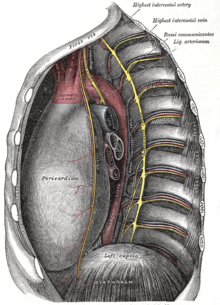Thoracic aorta
The thoracic aorta ("thoracic aorta") is a section of the main artery ( aorta ) in mammals. It is the direct continuation of the aortic arch and runs in the mediastinum towards the diaphragm . There it passes through the aortic slot ( hiatus aorticus ) and is then referred to as the abdominal aorta ( aorta abdominalis ).
The posterior intercostal arteries arise segmentally from the thoracic aorta ( arteriae intercostales posteriores , in animals called arteriae intercostales dorsales ), which supply the chest wall , thoracic spine , spinal cord and the back muscles in the thoracic area. It also has branches to supply the lungs ( Rami bronchiales ) and esophagus ( Rami oesophagei ). In many mammals these branches arise from a common main trunk , the arteria bronchooesophagea . In humans, the superior diaphragmatic artery ( Arteria phrenica superior ) also arises from the thoracic aorta, which is involved in the supply of the diaphragm.
If the wall of the thoracic aorta bulges, one speaks of a thoracic aortic aneurysm .
literature
- Uwe Gille: Cardiovascular and immune system, Angiologia. In: Franz-Viktor Salomon, Hans Geyer, Uwe Gille (Ed.): Anatomy for veterinary medicine. 2nd, revised and expanded edition. Enke, Stuttgart 2008, ISBN 978-3-8304-1075-1 , pp. 404-463.
